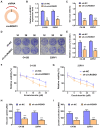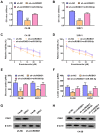circROBO1 promotes prostate cancer growth and enzalutamide resistance via accelerating glycolysis
- PMID: 37670963
- PMCID: PMC10475366
- DOI: 10.7150/jca.86940
circROBO1 promotes prostate cancer growth and enzalutamide resistance via accelerating glycolysis
Abstract
Background and aim: As non-coding RNAs, circular RNAs (circRNAs) contribute to the progression of malignancies by regulating various biological processes. In prostate cancer, however, there is still a lack of understanding regarding the potential molecular pathways and roles of circRNAs. Methods: Loss-off function experiments were performed to investigate the potential biological function of circRNA in the progression of prostate cancer. Western blot, qRT-PCR, and IHC assay were used to examine the expression level of different genes or circRNAs. Further molecular biology experiments were conducted to uncover the molecular mechanism underlying circRNA in prostate cancer using dual luciferase reporter and RNA immunoprecipitation (RIP) assays. Results: A novel circRNA (hsa_circ_0124696, named circROBO1) was identified as a significantly upregulated circRNA in both prostate cancer cells and tissues. Suppression of circROBO1 significantly attenuated the proliferation of prostate cancer cells. In addition, we found that the knockdown of circROBO1 remarkably increased the sensitivity of prostate cancer to enzalutamide treatment. A deceleration in glycolysis rate was observed after inhibition of circROBO1, which could suppress prostate cancer growth and overcome resistance to enzalutamide. Our results revealed that circROBO1 promotes prostate cancer growth and enzalutamide resistance via accelerating glycolysis. Conclusion: Our study identified the biological role of the circROBO1-miR-556-5p-PGK1 axis in the growth and enzalutamide resistance of prostate cancer, which is the potential therapeutic target of prostate cancer.
Keywords: PGK1; circROBO1; circular RNAs; enzalutamide resistance; prostate cancer.
© The author(s).
Conflict of interest statement
Competing Interests: The authors have declared that no competing interest exists.
Figures





Similar articles
-
Nanoparticles Mediated circROBO1 Silencing to Inhibit Hepatocellular Carcinoma Progression by Modulating miR-130a-5p/CCNT2 Axis.Int J Nanomedicine. 2023 Mar 30;18:1677-1693. doi: 10.2147/IJN.S399318. eCollection 2023. Int J Nanomedicine. 2023. PMID: 37020690 Free PMC article.
-
Matrine suppresses liver cancer progression and the Warburg effect by regulating the circROBO1/miR-130a-5p/ROBO1 axis.J Biochem Mol Toxicol. 2023 Oct;37(10):e23436. doi: 10.1002/jbt.23436. Epub 2023 Jun 28. J Biochem Mol Toxicol. 2023. PMID: 37376914
-
hsa_circ_0001275 Is One of a Number of circRNAs Dysregulated in Enzalutamide Resistant Prostate Cancer and Confers Enzalutamide Resistance In Vitro.Cancers (Basel). 2021 Dec 20;13(24):6383. doi: 10.3390/cancers13246383. Cancers (Basel). 2021. PMID: 34945002 Free PMC article.
-
Circ_0076305 facilitates prostate cancer development via sponging miR-411-5p and regulating PGK1.Andrologia. 2022 Jul;54(6):e14406. doi: 10.1111/and.14406. Epub 2022 Mar 2. Andrologia. 2022. PMID: 35238066
-
Hsa_circ_0000231 knockdown inhibits the glycolysis and progression of colorectal cancer cells by regulating miR-502-5p/MYO6 axis.World J Surg Oncol. 2020 Sep 29;18(1):255. doi: 10.1186/s12957-020-02033-0. World J Surg Oncol. 2020. PMID: 32993655 Free PMC article.
Cited by
-
Causal relationship between immune cells and prostate cancer: a Mendelian randomization study.Front Cell Dev Biol. 2024 Mar 19;12:1381920. doi: 10.3389/fcell.2024.1381920. eCollection 2024. Front Cell Dev Biol. 2024. PMID: 38566827 Free PMC article.
-
Circular RNA NFIX Functions as an Oncogene in Non-Small Cell Lung Cancer by Modulating the miR-214-3p/TRIAP1 Axis.Clin Respir J. 2024 Aug;18(8):e13801. doi: 10.1111/crj.13801. Clin Respir J. 2024. PMID: 39135128 Free PMC article.
-
Hsa_circ_0001492 regulates the hsa-miR-145-5p/ovarian carcinoma immunoreactive antigen domain 2 axis to promote the progression of lung adenocarcinoma.Biomol Biomed. 2025 Mar 7;25(4):940-953. doi: 10.17305/bb.2024.11140. Biomol Biomed. 2025. PMID: 39466086 Free PMC article.
-
COL10A1 Facilitates Prostate Cancer Progression by Interacting With INHBA to Activate the PI3K/AKT Pathway.J Cell Mol Med. 2024 Dec;28(23):e70249. doi: 10.1111/jcmm.70249. J Cell Mol Med. 2024. PMID: 39656597 Free PMC article.
-
A tumour-associated macrophage-based signature for deciphering prognosis and immunotherapy response in prostate cancer.IET Syst Biol. 2024 Oct;18(5):155-171. doi: 10.1049/syb2.12097. Epub 2024 Aug 13. IET Syst Biol. 2024. PMID: 39138838 Free PMC article.
References
-
- Sung H, Ferlay J, Siegel RL. et al. Global Cancer Statistics 2020: GLOBOCAN Estimates of Incidence and Mortality Worldwide for 36 Cancers in 185 Countries. CA: a cancer journal for clinicians. 2021;71(3):209–49. - PubMed
-
- Mottet N, Bellmunt J, Bolla M. et al. EAU-ESTRO-SIOG Guidelines on Prostate Cancer. Part 1: Screening, Diagnosis, and Local Treatment with Curative Intent. European urology. 2017;71(4):618–29. - PubMed
-
- Epstein JI, Amin MB, Reuter VE. et al. Contemporary Gleason Grading of Prostatic Carcinoma: An Update With Discussion on Practical Issues to Implement the 2014 International Society of Urological Pathology (ISUP) Consensus Conference on Gleason Grading of Prostatic Carcinoma. The American journal of surgical pathology. 2017;41(4):e1–e7. - PubMed
LinkOut - more resources
Full Text Sources
Research Materials
Miscellaneous

